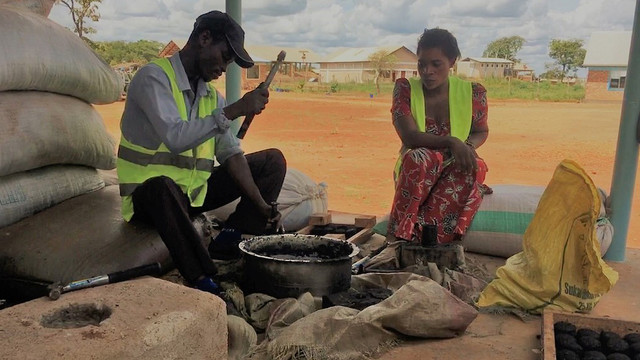Inclusive and integrated energy planning in Kitui County, Kenya
IIED and partners are supporting the Kitui county government in Kenya to develop an integrated energy plan using our ‘Energy Delivery Model’ approach.

Understanding community needs, impacts and gaps through participatory engagement (Photo: copyright Emmanuel Ngeywo/CAFOD)
IIED and the Catholic Agency for Overseas Development (CAFOD) have developed and tested the Energy Delivery Model (EDM) approach to designing energy services – as an inclusive planning tool since 2013.
The EDM Toolkit is a six-step problem-solving process. It is different from many other energy tools because it starts with the needs of communities and prioritises these throughout an iterative design process.
Rather than seeing energy as the end goal, it looks at a range of community members’ interests, such as improving local health clinics or earning a better living from farming. The process examines whether and how energy services could be designed to help achieve those goals, and what other interventions might be required.
The EDM approach places a high priority on understanding the local social-cultural context and working out how to design an energy service accordingly. Its inclusive and cross-sector approach creates longer lasting solutions that have local buy-in and achieve impacts that communities really value.
In 2010, Kenya established a devolved government system that includes moving the responsibility of energy planning to the county level, and the 2019 Energy Act mandated that county governments develop county energy plans (CEP) to meet the energy requirements of their country.
This gives county governments the scope to develop energy plans that take county-wide development needs into consideration and to work collaboratively with other sectors – such as water or education – so those sectors can improve their services through better access to energy. These policy developments offer an ideal opportunity to implement the EDM approach at scale in Kenya.
What is IIED doing?
With the Kenyan constitution and the Energy Act requiring all counties to develop a three-year CEP, IIED and CAFOD are collaborating with the Kitui county government, and local partners, to develop an integrated CEP for Kitui. Kitui is the first county in Kenya to use this approach.
IIED’s role is to co-lead the development of the CEP with CAFOD, manage the research and approach to stakeholder engagement that feeds into it, and train local partner Caritas Kitui to use the EDM tools.
The end product should be an inclusive CEP that is fully integrated into wider Kitui county development planning and has specific solutions that meet community-prioritised needs. One particular aim is to help the county government achieve scale (1.1 million people) and find synergies between sectors.
The EDM approach also aims to map and engage with finance and service providers to move quickly from planning to implementation by aggregating solutions for target communities or regions. Aggregating or bundling solutions across the county then reduces transaction costs and helps to attract these service providers and financiers.
Since 2018, the project partners have carried out a county-wide baseline survey, followed by an in-depth assessment at the household and community level, and across eight sectors (such as agriculture, health, education, small businesses) in the sub-counties.
Communities’ priorities have ranged from increasing their income from rain-fed and irrigated crop farming, to having better household lighting and access to clean water points located closer to their homes. We also worked with the World Resources Institute to use their GIS mapping tools for pulling out relevant county-level data (on demographics, water resources, renewable energy resource potential, for example).
The next step was to devise specific solutions across the priority sectors, including potential funding options and business models. Once the county government has agreed the solutions to be included in the CEP, the partners will develop full implementation plans.
These plans will include budgets and be firmly anchored in a cross-sector county plan. The CEP will also feed into the policies of both the national Ministry of Energy and power utility to ensure all plans and investments are properly aligned.
An inclusive planning approach
Alongside the technical analysis, the partners invest a lot of effort in building stakeholders’ awareness and buy-in for an inclusive planning approach, and seeking their inputs.
We provide advice for local officials tasked with developing the CEP and engage regularly with stakeholders such as county assembly members, staff at the Kitui energy department, energy companies, development agencies, local NGOs and business associations such as the chamber of commerce.
An important milestone took place in 2019, when we co-convened a regional inclusive and integrated planning workshop with Kenya’s Ministry of Energy. This brought together government, civil society and private sector participants from Kenya, Ethiopia, Tanzania and Uganda.
The Minister of Energy’s personal attendance, and the presence of officials from non-energy ministries (such as water and agriculture) sent promising signals there is real appetite for the type of inclusive, coordinated approaches needed to achieve energy for all.
Additional resources
Video: Energy enabling green development in Kitui County, Kenya (September 2023)
Video: Over 90% of Kenya's rural cook with wood or charcoal, news report by CGTN Africa
Podcast: Delivering energy access for all: Make Change Happen podcast episode 2 (2019)
Towards energy access for all: planning for impact, Surabhi Rajagopal (2019), Low Carbon Energy for Development Network Briefing
Video: Kitui County rolls out an energy master plan to tap natural resources (2018)
Using the EDM toolkit to analyse impact: a small-scale horticulture project in Kenya, Surabhi Rajagopal, Ben Garside, Lazarus Walker, Sarah Wykes (2017), Toolkit
Planning pro-poor energy services for maximum impact: the Energy Delivery Model Toolkit, Ben Garside, Sarah Wykes (2017), Toolkit




